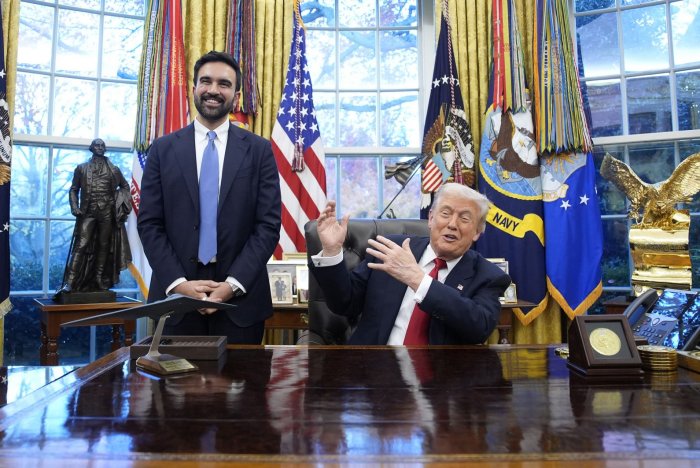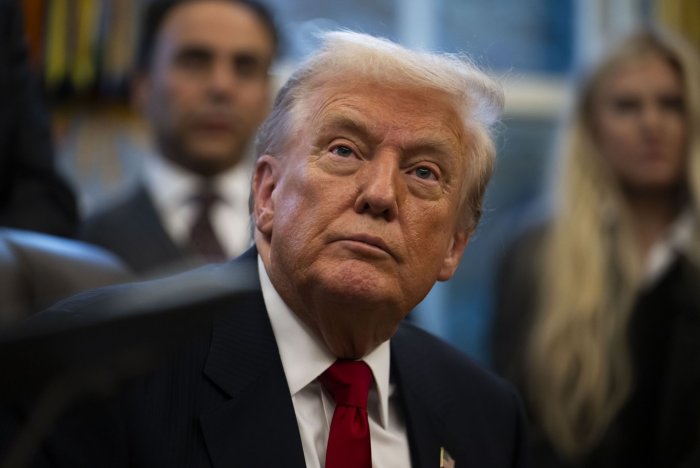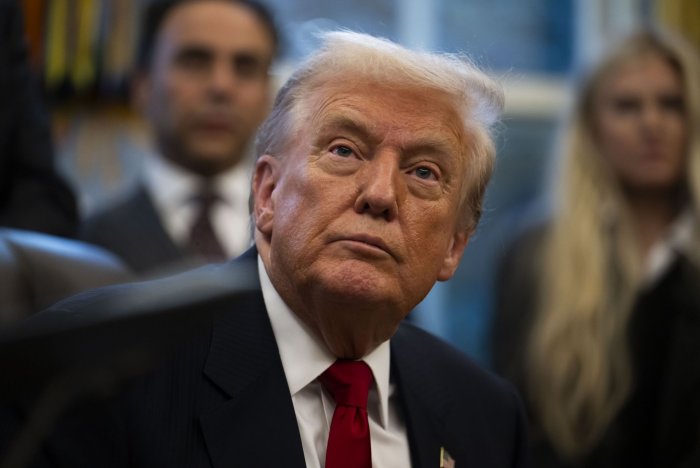Nov. 12 (UPI) — President Donald Trump late Wednesday signed legislation to reopen the federal government, resuming programs and again paying millions of workers, blaming Democrats for the longest shutdown in history at 43 days.
The new stopgap bill will fund the government through Jan. 30, and provide a full year of funding for the Supplemental Nutrition Assistance Program and veterans programs. Furloughed employees are expected to return to report on Thursday.
The U.S. House, convening for the first time in two months, approved legislation sent two days earlier by the Senate. Most Democrats and Republicans have been on opposite sides on enhanced health insurance subsidies through the Affordable Care Act.
At 8:21 p.m., the House voted 222-209 to send the stopgap funding bill to the president. The outcome wasn’t strictly along party lines with six Democrats voting yes and two Republicans voting no. There were two not voting and two vacancies.
Two hours later, Trump appeared in the Oval Office with U.S. House Speaker Mike Johnson, Senate Majority Leader John Thune — both Republicans — as well as other House members. Also, financial industry leaders, whom he dined with earlier at the White House, watched the signing.
“I just want to tell the American people, you should not forget this when we come up to midterms and other things,” Trump said about elections in 2026 for the House and Senate. “Don’t forget what they’ve done to our country.”
In the public ceremony, Trump blasted the Affordable Care Act as “Obama madness,” bragged about the record-high stock market and spoke about gas prices around $2.50 a gallon. He didn’t take any questions from reporters.
Trump wants Obamacare to be scrapped.
“We’ll work on something having to do with healthcare,” said Trump, who hasn’t been able to find a replacement since first being president in 2017. “We can do a lot better.”
He has proposed bypassing providers with direct payment to users, who then could purchase their own plans.
“I’m calling today for insurance companies not to be paid,” Trump said, “but for this massive amount of money to be given directly to the people.” Basic Medicare is administered by the government rather than companies.
The House had been out of session since Sept. 19, when it passed the first version of a continuing resolution to temporarily fund the government. The Senate held 14 votes on the same legislation, but failed to reach the 60-vote supermajority needed to pass it.
The House originally approved the spending bill on a majority vote, but the Senate needed 60 votes and approval was held up in finding enough Democrats to agree to legislation that doesn’t guarantee enhanced health insurance subsidies starting Jan. 1.
The GOP holds a 53-47 edge.
Trump again on Wednesday night called for an end to the filibuster, saying “if we had the filibuster terminated, this would never happen again.”
Most Republicans have opposed this “nuclear option,” because Democrats could use it when they are in power.
After the House Rules Committee advanced the Senate bill Tuesday night, the full chamber convened at 4:08 p.m., and began debate for one hour at 4:36 p.m. The bill advanced 213-209.
The GOP has a 219-214 advantage, with Democrat Adelita Grijalvi having been sworn in when the House convened. She was elected Sept. 23. There are two vacancies.
Government reopens
At least 670,000 federal employees furloughed will return to work and roughly 730,000 essential workers, including air traffic control workers, will be paid, according to the Bipartisan Policy Center.
The White House’s Office of Management and Budget furloughed workers will return on Thursday.
“Agencies should take all necessary steps to ensure that offices open in a prompt and orderly manner on November 13, 2025,” the memorandum released Wednesday night reads.
Essential workers had to work without pay, including air traffic control personnel. This resulted in several thousand flights being canceled.
Government programs also will resume, including 42 million people receiving monthly payments from the Supplemental Nutrition Assistance Program. For the first time in history, November money wasn’t sent electronically.
“For 40 days, hardworking Americans have endured flight cancellations, missed paychecks and empty dinner tables – all because Democrats closed the government,” Johnson posted on X with a video before the vote.
“It was foolish, pointless, cruel and entirely avoidable. Republicans have been working every day to get the government reopened for the American people, and today we should finally be able to overcome the Democrats and accomplish our mission.”
Divided on insurance subsidies
The program, which became known as Obamacare, was approved in 2010 during Barack Obama’s presidency. A record 25 million were enrolled this year.
The credits were enhanced in 2021 by the American Rescue Plan Act during the pandemic and extended one year later through 2015. They increased the amount of financial assistance, expanded eligibility and capped the percentage of household income for the benchmark silver plan.
Eight senators who caucus with the Democrats voted Monday in favor of the new bill on Tuesday night, allowing the chamber to pass it with a vote of 60-40.
The Senate broke the impasse over the weekend after Republicans agreed to hold a separate vote on ACA tax credits in December.
On Wednesday night, Johnson told reporters that Republicans are “pulling together the best ideas that we think can, in the quickest fashion, bring premiums down.”
And that includes working with Democrats.
“I sent a note to Hakeem Jeffries and I said, ‘Look, we would love to do this in a bipartisan fashion,’ you know, and he and I exchanged texts yesterday about that.”
Democrats focus on healthcare
Jeffries unsuccessfully attempted a three-year extension of Obamacare by a discharge petition. There would be a vote if the minority party can secure support for a majority of the chamber — a total of 218 signatures. But there are only 214 Democrats and there wasn’t sufficient GOP backing.
“Affordable Care Act tax credits were extended by three years in the Inflation Reduction Act,” Jeffries said outside the Capitol before the House convened. “The legislation that we will introduce in the context of the discharge petition will provide that level of certainty to working-class Americans who are on the verge of seeing their premiums, copays and deductibles skyrocket in some cases, experiencing increases of $1,000 or $2,000 per year.”
Jeffries said Democrats will continue to fight on healthcae.
“We’ll continue to fight for the principle that in this great country, the wealthiest country in the history of the world, healthcare can’t simply be a privilege available only to the well-off, the wealthy and the well-connected.
“Healthcare must be a right available to every single American. And that’s the fight that House Democrats will continue to wage for the American people.”
Colorado Rep. Jeff Hurd said he wanted to extend the enhanced premium tax credits for time to work on “the underlying drivers that are pushing up those health care costs to begin with.”
Workers union wants healthcare addresses
The American Federation of State, County and Municipal Employees, with 1.4 million members, called on Congress to help Americans afford health insurance.
“AFSCME members have been clear from the start of this shutdown: we need to lower health care costs and fund public services,” AFSCME President Lee Saunders said in a statement to UPI.
“Unfortunately, this administration and the Project 2025 ideologues in Congress refused to come to the table to address the healthcare crisis gripping families across the country. We applaud all of the leaders in Congress who stood up and sounded the alarm about the massive insurance premium hikes affecting millions of Americans.
“The fight to protect families from these increases is far from over. Now that the government is reopening, we’re calling on members of Congress to keep their promise and hold a vote to extend the Affordable Care Act tax credits. Working families cannot afford to wait any longer to lower health care costs.”
Provision on suing DOJ
The legislation includes funds for eight senators to sue the Department of Justice for obtaining their phone records during an investigation when Joe Biden was president.
Rather than removing the provision and returning it to the Senate, Johnson said he plans to have separate legislation next week.
“I was very angry about it,” Johnson said. “I was, and a lot of my members called me and said, ‘Did you know about it?’ We had no idea. That was dropped in at the last minute. And I did not appreciate that, nor did most of the House members. Many of them were very – are very angry about that.”
Democrats also opposed the provision.
“What makes this corruption so staggering is that the payout is specifically designed to go to eight senators whose phone records were lawfully subpoenaed under due process by the Department of Justice,” Rep. Rosa DeLauro, the top Democrat on the House Appropriations panel, wrote in a statement.
She accused the senators of voting “to shove taxpayer dollars into their own pockets — $500,000 for each time their records were inspected.”
Daniel Haynes contributed to this report.
President Donald Trump speaks to members of the media during a swearing in ceremony for Sergio Gor, the new U.S. Ambassador to India, in the Oval Office of the White House on Monday. Photo by Craig Hudson/UPI |
License Photo







